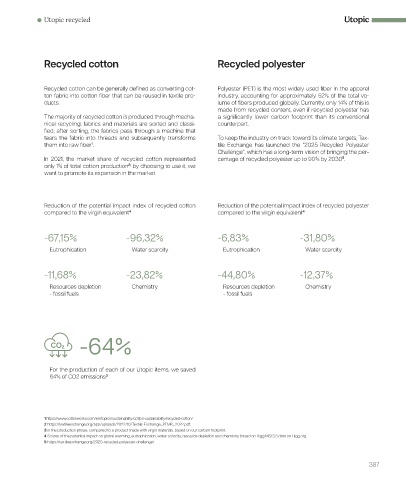Page 389 - ON
P. 389
Utopic recycled
Recycled cotton Recycled polyester
Recycled cotton can be generally defined as converting cot- Polyester (PET) is the most widely used fiber in the apparel
ton fabric into cotton fiber that can be reused in textile pro- industry, accounting for approximately 52% of the total vo-
ducts. lume of fibers produced globally. Currently, only 14% of this is
made from recycled content, even if recycled polyester has
The majority of recycled cotton is produced through mecha- a significantly lower carbon footprint than its conventional
nical recycling: fabrics and materials are sorted and classi- counterpart.
fied; after sorting, the fabrics pass through a machine that
tears the fabric into threads and subsequently transforms To keep the industry on track toward its climate targets, Tex-
them into raw fiber . 1 tile Exchange has launched the “2025 Recycled Polyester
Challenge”, which has a long-term vision of bringing the per-
In 2021, the market share of recycled cotton represented centage of recycled polyester up to 90% by 2030 . 5
only 1% of total cotton production by choosing to use it, we
2;
want to promote its expansion in the market
Reduction of the potential impact index of recycled cotton Reduction of the potential impact index of recycled polyester
compared to the virgin equivalent 4 compared to the virgin equivalent 4
-67,15% -96,32% -6,83% -31,80%
Eutrophication Water scarcity Eutrophication Water scarcity
-11,68% -23,82% -44,80% -12,37%
Resources depletion Chemistry Resources depletion Chemistry
- fossil fuels - fossil fuels
-64%
For the production of each of our Utopic items, we saved
64% of CO2 emissions 3
1 https://www.cottonworks.com/en/topics/sustainability/cotton-sustainability/recycled-cotton/.
2 https://textileexchange.org/app/uploads/2022/10/Textile-Exchange_PFMR_2022.pdf.
3 in the production phase, compared to a product made with virgin materials, based on our carbon footprint.
4 Scores of the potential impact on global warming, eutrophication, water scarcity, resource depletion and chemistry based on Higg MSI 3.3 data on Higg.org.
5 https://textileexchange.org/2025-recycled-polyester-challenge/
387

